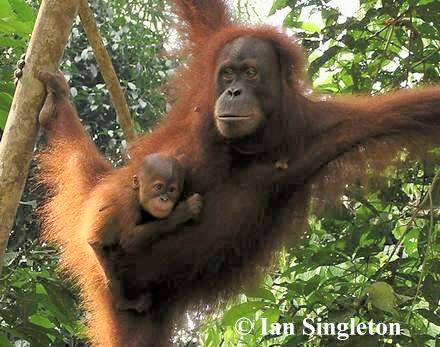 Orangutans are facing multiple different threats. Once widespread throughout Southeast Asia, today they exist only on the islands of Borneo and Sumatra.
Orangutans are facing multiple different threats. Once widespread throughout Southeast Asia, today they exist only on the islands of Borneo and Sumatra.
The orangutan is critically endangered in Borneo where most recent estimates put the population at just under 105,000. OURF has focused its efforts on the critically endangered populations in Sumatra, which numbers only about 14,470 (IUCN 2016).
Like most of Indonesia, Sumatra was once blanketed with tropical forests, and orangutans lived throughout the island. Smaller, lighter-colored, and generally more social than the better-known Bornean orangutan, today the Sumatran orangutan is found only in the island’s northern parts. Legal and illegal logging, large-scale forest conversion, mining, and development brought about the extinction of southern populations and continue to fragment the remaining populations.
Satellite imagery shows that 48% of Sumatra's natural forest cover has disappeared since 1985 (WWF, 2008), and up to 800 orangutans are being lost every year as a result of habitat destruction and hunting. If the current rate of decline continues, orangutans will be extinct as a genetically viable species in Sumatra within just 10 years.
Orangutans have the longest birth interval of any land mammal, with females giving birth to one baby every six to eight years from the age of 15, and usually producing no more than three to four offspring in their lifetime. With such a low birth rate, they're particularly vulnerable to hunting pressure and habitat destruction. All of the orangutans in Sumatra are scattered throughout small patches of forest that are surrounded by human settlements and plantations, isolated from neighboring populations. All of their remaining habitat is currently under serious threat of destruction.
The biggest stronghold of the orangutan is the Leuser ecosystem, an area of approximately 2.6 million hectares in northern Sumatra which contains two major volcanoes, three lakes, and nine major river systems, 4.2% of all known bird species, and 2.6% of all known mammals. It's the only place on earth where Sumatran orangutans, tigers, elephants, and rhinos - all of which are critically endangered - are found in one area. It's also one of Asia’s largest carbon sinks, and critical to regulating climate (Global Forest Watch, 2015). The ecosystem includes Gunung Leuser National Park, which has been subjected to widespread legal and illegal logging, encroachment, habitat destruction to create palm oil plantations, forest fires, and the Ladia Galaska road development, which bisected the park into two sections (EIA, 1999).
The most southerly populations of wild orangutans are in the West Batang Toru forest blocks of North Sumatra province. Genetic testing performed in 2017 revealed these orangutans to be a genetically distinct species, which scientists call the Tapanuli orangutan. Only 800 of these animals remain. Hunting by local people for sustenance and the pet trade and illegal logging is putting increasing pressure on these populations (SOCAP Workshop Report, 2005).
For the past decade, The Orangutan Project (whom we partner with) and other organizations have reestablished a Sumatran orangutan population in the Bukit Tigapuluh National Park, a 320,000-hectare expanse of forest in Jambi and Riau provinces by releasing over 130 ex-captive orangutans into the landscape. This forest is extraordinarily rich in biodiversity and hosts at least 80 mammal species, including roughly 30 tigers, 150 elephants, 193 species of birds, 98 species of fish, and four species of reptiles. It also includes the 134,834-hectare Bukit Tigapuluh National Park. Despite a history of agricultural encroachment and logging, much of the park and greater landscape remains substantially wild. However, forest concessions to pulp and paper companies in recent years caused massive deforestation. New plans by these companies to convert more forest blocks on the border of the park into plantations directly threaten this biodiversity and the orangutan release project (KKI Warsi, 2010).
To respond to these threats, OUREI organized a conference, workshop, and summit in 2006 to bring stakeholders together to create an education curriculum that addresses the conflict between humans and orangutans in Sumatra. Working with our Indonesian partners (the Sumatran Orangutan Conservation Program, Sumatran Orangutan Society, Orangutan Caring Club of North Sumatra, Fauna and Flora International, and the Leuser International Foundation), we delivered the curriculum to audiences near orangutan habitat in the provinces of North Sumatra and Aceh, explaining to local people the importance of orangutans as a species and the overwhelming importance of their forest home. In 2008, we expanded the program to include academic institutions and broadcast media, and the annual Orangutan Caring Week event continues to inspire young people in the Medan area of the island.
The challenges facing orangutans in Sumatra have never been greater, but with continued conservation efforts and OURF’s expanding education program, we hope that Asia’s great orange ape and its forest home can survive.
Borneo is the world’s third-largest island. Surrounded by the South China Sea to the north and northwest and lying to the east of Sumatra, Borneo has a human population of around 18.5 million, with the majority of settlements near the coastline or Borneo’s extensive river system (Smith, 2007).
More than 100,000 Bornean orangutans vanished from Borneo between 1999 and 2015. While deforestation played a major role, most of the orangutans disappeared from areas that are still mostly forested, which indicates that hunting is another major problem (Voigt et. al., 2018).
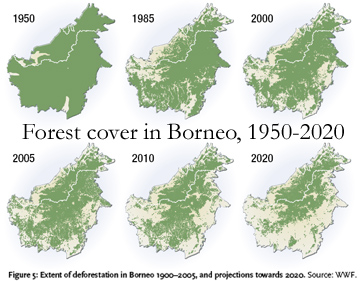
Like Sumatra, Borneo is extraordinarily rich in biodiversity. It's home to 3,000 species of trees, 15,000 species of flowering plants, 221 species of terrestrial mammals, (including 13 species of primate), and more than 400 species of birds (Mackinnon et. al., 1997). However, like Sumatra, widespread logging and the growing palm oil industry have destroyed half of the island's forest cover (Matthews, 2002). The area slated for logging and oil palm cultivation in Borneo is now larger than that of the remaining forest (Rijsken & Meijaard, 1999).
The most recent estimates put the population of Bornean orangutans at around 55,000 (Wich et. al., 2008), and the species, better known and generally better studied than its Sumatran cousin, has benefited from both a strong international NGO presence, and Borneo’s series of national parks, which, despite massive incursions and continued threats, today harbor significant populations of orangutans. In 2016, the IUCN reclassified the Bornean orangutan as "critically endangered" primarily due to the continued habitat degradation (IUCN Redlist, 2016).
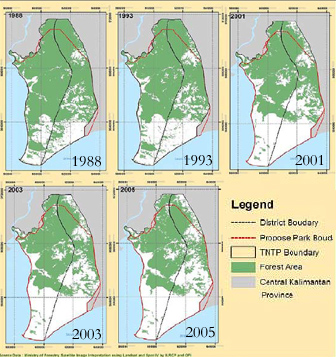 Kalimantan is divided into five provinces: Central, West, East, North, and South. The two national parks with the largest orangutan populations are found in Central Kalimantan. The most famous, Tanjung Puting, is a 400,000-hectare park renowned for its long-term wild orangutan study and rehabilitation program. Despite its high profile and strong NGO presence, the park has been subjected to widespread illegal logging, conversion, for both palm oil production and agriculture, forest fires, and illegal gold mining, and studies conducted in 2009 showed that just 66% of the park remains under some kind of forest cover (Infinite Earth, 2009). If current plans by the local government to decrease the size of the park by 25% take place, thousands of orangutans will be lost. Sebangau National Park was created as a national park in 2004 and covers an area of 568,700 hectares. Like Tanjung Puting, the park has been subjected to incursions, and the historic draining of the parks’ peat swamps, to aid the extraction of logs from the forest, has left it prone to almost annual fires. Despite this, the two parks have a combined orangutan population of around 12,000 orangutans (Singleton et. al., 2004).
Kalimantan is divided into five provinces: Central, West, East, North, and South. The two national parks with the largest orangutan populations are found in Central Kalimantan. The most famous, Tanjung Puting, is a 400,000-hectare park renowned for its long-term wild orangutan study and rehabilitation program. Despite its high profile and strong NGO presence, the park has been subjected to widespread illegal logging, conversion, for both palm oil production and agriculture, forest fires, and illegal gold mining, and studies conducted in 2009 showed that just 66% of the park remains under some kind of forest cover (Infinite Earth, 2009). If current plans by the local government to decrease the size of the park by 25% take place, thousands of orangutans will be lost. Sebangau National Park was created as a national park in 2004 and covers an area of 568,700 hectares. Like Tanjung Puting, the park has been subjected to incursions, and the historic draining of the parks’ peat swamps, to aid the extraction of logs from the forest, has left it prone to almost annual fires. Despite this, the two parks have a combined orangutan population of around 12,000 orangutans (Singleton et. al., 2004).
An ambitious, multi-stakeholder, and multi-national plan to conserve 91,000 hectares on the border of Tanjung Puting National Park was, in September 2011, in the final stages of development, and would have formed Indonesia’s first REDD reserve, whereby outside investors agreed to fund conservation of carbon-rich peat forests in return for offsetting their carbon emissions. However, despite international support and hopes that the project would act as an example to other such efforts, at the last minute, the national government decided to cut the size of the reserve, known as Rimba Raya, in half, handing one side to a palm oil company. Since then, conservationists have tried hard to convince the government of the project's worth, and in December 2012, their efforts seemed to have paid off; the government announced that 80,000 hectares would be set aside as a reserve. Although the implementation of such a project, the first of its kind in Indonesia, remains challenging, and many remain convinced its goals are unrealistic, it is hoped that over 30 years, the reserve will generate between $390 to 650 million worth of carbon offset credits, providing a financial incentive for local people, businesses and governments to protect the reserve.
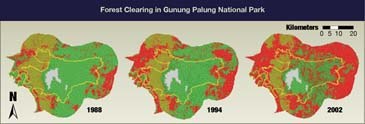 Gunung Palung National Park is a 90,000-hectare park in West Kalimantan known for its high biodiversity and mixture of habitat types. Despite being the site of a long-term wild orangutan study, having a strong international NGO presence, and being one of the province's most popular tourist destinations, the park has been heavily logged, and its 2500 wild orangutans are under constant threat. In November 2011, illegal logging in the park was so bad it reached the study area of a well-known long-term scientific research project, and all scientific researchers were told to leave the park. Two other national parks in West Kalimantan, Danau Sentarum and Betung Kerihun, have also suffered from logging, and studies indicate that the former contains an orangutan population of just 500 individuals (Singleton et. al., 2004), and the latter has suffered from widespread poaching, with an unknown population (WWF, 2010). Although NGO presence and conservation initiatives in these parks are increasing, efforts are hampered by the fact that large numbers of orangutans occur in legally unprotected forests outside the park borders.
Gunung Palung National Park is a 90,000-hectare park in West Kalimantan known for its high biodiversity and mixture of habitat types. Despite being the site of a long-term wild orangutan study, having a strong international NGO presence, and being one of the province's most popular tourist destinations, the park has been heavily logged, and its 2500 wild orangutans are under constant threat. In November 2011, illegal logging in the park was so bad it reached the study area of a well-known long-term scientific research project, and all scientific researchers were told to leave the park. Two other national parks in West Kalimantan, Danau Sentarum and Betung Kerihun, have also suffered from logging, and studies indicate that the former contains an orangutan population of just 500 individuals (Singleton et. al., 2004), and the latter has suffered from widespread poaching, with an unknown population (WWF, 2010). Although NGO presence and conservation initiatives in these parks are increasing, efforts are hampered by the fact that large numbers of orangutans occur in legally unprotected forests outside the park borders.
Kutai National Park in East Kalimantan was once one of the most pristine and bio-diverse parks in Indonesia, but in the last few decades, the park has been invaded by logging concessions, industrial complexes, open-pit coal mines, and settlements, ravaged by forest fires, and just 10% of the park likely remains forested, with an orangutan population of just 500 (Singleton et. al., 2004). Media reports in 2009 suggested the population could be even lower and reported that the park now contains an airport, gas stations, and even a prostitution complex (Mongabay, 2009). A new project set up by the University of Toronto has found that, despite these threats, orangutans are living in parts of the park in high densities, and that habitat is recovering well from damage. Although the project is in its early stages, increased conservation efforts should hopefully bring increased awareness to this area.
As national parks throughout the island continue to struggle against the onslaught of huge palm oil expansion and logging, attention is being increasingly focused on the areas of forest outside of the national park system. In Central Kalimantan, conservationists are working to protect the 76,000-hectare Lamandau Nature Reserve, an expired logging concession comprised mainly of peat swamp, which acts as a rehabilitated orangutan release site, and the Belantikan Hulu region, which is home to an estimated 6,000 orangutans, the largest population outside of a protected area. NGOs have also been working to protect the 377,000-hectare Mawas Reserve, home to 3,500 orangutans, in Central Kalimantan, and an ambitious plan by WWF to conserve 22 million hectares of land, an area that encompasses protected areas, reserves, sustainably managed buffer zones, and wildlife corridors, called the ‘Heart of Borneo’, would, if successful, protect thousands of orangutans in the center of the island. The publicity surrounding this scheme seems to have thwarted a plan by the Indonesian and Malaysian governments to establish the world’s largest palm oil plantation in this area, but the threat remains ever-present.
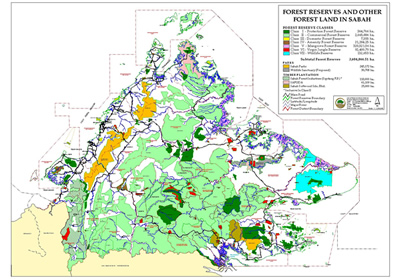 Like Kalimantan, the orangutans in the Malaysian states of Sarawak and Sabah have long faced rapidly decreasing forests, and the spread of palm oil plantations has forced remaining orangutans into small, isolated populations in heavily degraded forests. Sabah contains a population of just 11,000 orangutans, and around 60% of this number are living outside of protected areas, in secondary forests often exploited by indigenous communities and forest industries. In-depth studies in the Kinabatangan floodplain, which harbors 1,100 orangutans, have shown that they can survive in high numbers in degraded secondary forest (Ancrenaz et. al., 2007), and the formation of the Lower Kinabatangan Wildlife Sanctuary in this area is a promising step for the survival of orangutans in Sabah.
Like Kalimantan, the orangutans in the Malaysian states of Sarawak and Sabah have long faced rapidly decreasing forests, and the spread of palm oil plantations has forced remaining orangutans into small, isolated populations in heavily degraded forests. Sabah contains a population of just 11,000 orangutans, and around 60% of this number are living outside of protected areas, in secondary forests often exploited by indigenous communities and forest industries. In-depth studies in the Kinabatangan floodplain, which harbors 1,100 orangutans, have shown that they can survive in high numbers in degraded secondary forest (Ancrenaz et. al., 2007), and the formation of the Lower Kinabatangan Wildlife Sanctuary in this area is a promising step for the survival of orangutans in Sabah.
The Batang Ai National Park, a 24,281-hectare tropical rainforest, and the nearby Lanjak Entimau Wildlife Sanctuary are two of the last strongholds of the orangutan in Sarawak, with a combined population of around 1,500 (Singleton et. al., 2004). Although these parks are generally well protected, hunting and illegal logging remain a problem in this area (Caldecott & McConkey, 2006), and the threat of these forests being converted in the future to facilitate palm oil expansion remains strong.
The threats facing the forests of Kalimantan, Sabah, and Sarawak, and the animals and people who depend on them, have never been greater. However, with continued environmental awareness, growing prosperity in both Malaysia and Indonesia, and international pressure, it is hoped the future of these great forests can be ensured.
Ancranaz M., Dabek, L. & O'Neil, S. (2007). The cost of exclusion: Recognizing a role for local communities in biodiversity conservation. PLoS Biology, 5 (11).
Caldecott, J. & McConkey, K. R, (2006). Orangutan Overview. In J. Caldecott and L. Miles, editors. World Atlas of Great Apes and their Conservation. UNEP-WCMC and University of California Press, London.
EIA. (1999). The Final Cut. Environmental Investigation Agency report, UK.
Global Forest Watch. (11/27/2015). Indonesia Leuser Ecosystem. https://data.globalforestwatch.org/datasets/16dae98167264b8abfbd13e23802e4f3_0.
IUCN. (2016). IUCN Redlist: Bornean Orangutan.
KKI Warsi. (2010). Last chance to save Bukit Tigapuluh. WWF.
MacKinnon, K, Hatta, G., Halim, H. & Mangalik, A. (1997). The Ecology of Kalimantan. Oxford University Press, UK.
Marshall, A.J., Nardiyono., Engstrom, L.M., Pamungkas, B., Palapa, J., Meijaard, E. & Stanley, S.A. (2006). The blowgun is mightier than the chainsaw in determining population density of Bornean orangutans (Pongo pygmaeus morio) in the forests of East Kalimantan. Biological Conservation, 129, pp. 566-578.
Mongabay (2009). Orangutan population in Borneo park plunges 90% in 5 years. Mongabay.com.
Rijksen H. & Meijaard E. (1999). Our vanishing relative. The status of wild orangutans at the turn of the 20th century. Kluwer academic Publishers, Netherlands.
Singleton, I., Wich, S., Husson, S., Stephens, S., Utami Atmoko, S., Leighton, M., Rosen, N., Traylor-Holzer, K., Lacy, R. & Byers, O. (2004). Orangutan population and habitat viability assessment: Final report. IUCN/SSC Conservation Breeding Specialist Group, Apple Valley, MN.
Smith D.A. (2007). The conservation status of the primates of Borneo. Oxford Brookes University MSc Dissertation.
Voigt, Maria, et. al. Global Demand for Natural Resources Eliminated More Than 100,000 Bornean Orangutans. Current Biology, Volume 28, Issue 5, 761 - 769.e5.
WWF. (2010). Borneo. WWF.
WWF. (2019). Orangutan. WWF. https://www.worldwildlife.org/species/orangutan.
WWF. (2008). Sumatra. WWF.